Tectonic Transition from Passive to Active Continental Margin of Nenjiang Ocean: Insight from the Middle Devonian-Early Carboniferous Granitic Rocks in Northern Great Xing’an Range, NE China
Abstract
1. Introduction
2. Geological Setting
3. Sample Collection and Analytical Methods
3.1. Sample Collection
3.2. Analytical Methods
4. Results
4.1. Geochemistry
4.2. Zircon LA-ICP-MS U-Pb Dating
4.3. Zircon Lu-Hf Isotopic
5. Discussion
5.1. A Paleozoic Tectono-Magmatism Quiet Period
5.2. Petrogenesis
5.3. Tectonic Setting
5.3.1. Middle Devonian
5.3.2. Late Devonian to Early Carboniferous
6. Conclusions
- (1)
- We recently found Middle Devonian to Early Carboniferous small scale granitic rocks with the ages of 389 Ma, 368 Ma, and 351 Ma. The granitic rocks of 389 Ma and 368 Ma indicate that there was still few granitic plutons during the quiet stage of magmatism in the Devonian.
- (2)
- Geochemistry and zircon Hf isotope characteristics show that the Middle Devonian to Early Carboniferous granitic rocks formed in a subduction-related tectonic setting and derived from partial melting of lower crustal igneous rocks and without significance magmatic fractionation during their crystal process.
- (3)
- The northwestward subduction of the Nenjiang Ocean plate initiated locally in the Middle Devonian and became widespread in the Late Devonian and Early Carboniferous with time. Finally, the bidirectional subduction of the Nenjiang Ocean might have started in the Early Carboniferous.
Supplementary Materials
Author Contributions
Funding
Acknowledgments
Conflicts of Interest
References
- Xiao, W.J.; Huang, B.C.; Han, C.M.; Sun, S.; Li, J.L. A Review of the Western Part of the Altaids: A key to Understanding the Architecture of accretionary orogens. Gondwana Res. 2010, 18, 253–273. [Google Scholar] [CrossRef]
- Xiao, W.J.; Sun, M.; Santosh, M. Continental reconstruction and metallogeny of the Circum-Junggar areas and termination of the southern Central Asian Orogenic Belt. Geosci. Front. 2015, 6, 137–140. [Google Scholar] [CrossRef]
- Windley, B.F.; Alexeiev, D.; Xiao, W.J.; Kröner, A.; Badarch, G. Tectonic models for accretion of the Central Asian Orogenic Belt. J. Geol. Soc. 2007, 164, 31–47. [Google Scholar] [CrossRef]
- Li, S.; Wilde, S.A.; He, Z.J.; Jiang, X.J.; Liu, R.Y.; Zhao, L. Triassic sedimentation and post accretionary crustal evolution along the Solonker suture zone in Inner Mongolia, China. Tectonics 2014, 33, 960–981. [Google Scholar] [CrossRef]
- Li, S.; Chung, S.L.; Wilde, S.A.; Jahn, B.M.; Xiao, W.J.; Wang, T.; Guo, Q.Q. Early-middle Triassic high Sr/Y granitoids in the southern Central Asian Orogenic Belt: Implications for ocean closure in accretionary orogens. J. Geophys. Res. 2017, 122, 2291–2309. [Google Scholar] [CrossRef]
- Wilde, S.A. Final amalgamation of the Central Asian Orogenic Belt in NE China: Paleo-Asian Ocean closure versus Paleo-Pacific plate subduction—A review of the evidence. Tectonophysics 2015, 662, 345–362. [Google Scholar] [CrossRef]
- Xu, B.; Zhao, P.; Wang, Y.Y.; Liao, W.; Luo, Z.W.; Bao, Q.Z.; Zhou, Y.H. The pre-Devonian tectonic framework of Xing‘an–Mongolia orogenic belt (XMOB) in north China. J. Asian Earth Sci. 2015, 97, 183–196. [Google Scholar] [CrossRef]
- Liu, Y.J.; Li, W.M.; Feng, Z.Q.; Wen, Q.B.; Neubauer, F.; Liang, C.Y. A review of the Paleozoic tectonics in the eastern part of Central Asian Orogenic Belt. Gondwana Res. 2017, 43, 123–148. [Google Scholar] [CrossRef]
- Windley, B.F.; Kröner, A.; Guo, J.H.; Qu, G.S.; Li, Y.Y.; Zhang, C. Neoproterozoic to Paleozoic geology of the Altai orogen, NW China: New zircon age data and tectonic evolution. J. Geol. 2002, 110, 719–739. [Google Scholar] [CrossRef]
- Xiao, W.J.; Windley, B.F.; Hao, J.J.; Zhai, M.G. Accretion leading to collision and the Permian Solonker suture, Inner Mongolia, China: Termination of the Central Asian Orogenic Belt. Tectonics 2003, 22, 1069–1089. [Google Scholar] [CrossRef]
- Xiao, W.J.; Windley, B.F.; Huang, B.C.; Han, C.M.; Yuan, C.; Chen, H.L.; Sun, M.; Sun, S.; Li, J.L. End-Permian to Mid-Triassic termination of the accretionary processes of the southern Altaids: Implications for the geodynamic evolution, Phanerozoic continental growth, and metallogeny of Central Asia. Int. J. Earth Sci. 2009, 98, 1189–1217. [Google Scholar] [CrossRef]
- Xiao, W.J.; Windley, B.F.; Sun, S.; Li, J.L.; Huang, B.C.; Han, C.M.; Yuan, C.; Sun, M.; Chen, H.L. A tale of amalgamation of three Permo-Triassic Collage Systems in Central Asia: Oroclines, sutures, and terminal accretion. Annu. Rev. Earth Planet. Sci. 2015, 43, 477–507. [Google Scholar] [CrossRef]
- Xiao, W.J.; Windley, B.F.; Han, C.M.; Liu, W.; Wan, B.; Zhang, J.E.; Ao, S.J.; Zhang, Z.Y.; Song, D.F. Late Paleozoic to early Triassic multiple roll-back and oroclinal bending of the Mongolia college in Central Asia. Earth-Sci. Rev. 2018, 186, 94–128. [Google Scholar] [CrossRef]
- Jahn, B.M. The Central Asian Orogenic Belt and growth of the continental crust in the Phanerozoic. In Aspects of the Tectonic Evolution of China; Malpas, J., Fletcher, C.J.N., Ali, J.R., Aitchison, J.C., Eds.; Geological Society of London, Special Publication: London, UK, 2004; Volume 226, pp. 73–100. [Google Scholar]
- Kröner, A.; Demoux, A.; Zack, T.; Rojas-Agramonte, Y.; Jian, P.; Tomurhuu, D.; Barth, M. Zircon ages for a felsic volcanic rock and arc-related early Palaeozoic sediments on the margin of the Baydrag microcontinent, central Asian orogenic belt, Mongolia. J. Asian Earth Sci. 2011, 42, 1008–1017. [Google Scholar] [CrossRef]
- Kröner, A.; Alexeiev, D.V.; Rojas-Agramonte, Y.; Hegner, E.; Wong, J.; Xia, X.; Belousova, E.; Mikolaichuk, A.V.; Seltmann, R.; Liu, D.; et al. Mesoproterozoic (Grenvilleage) terranes in the Kyrgyz North Tianshan: Zircon ages and Nd-Hf isotopic constraints on the origin and evolution of basement blocks in the southern Central Asian Orogen. Gondwana Res. 2013, 23, 272–295. [Google Scholar] [CrossRef]
- Feng, Z.Q.; Liu, Y.J.; Liu, B.Q.; Wen, Q.B.; Li, W.M.; Liu, Q. Timing and nature of the Xinlin-Xiguitu Ocean: Constraints from ophiolitic gabbros in the northern Great Xing’an Range, eastern Central Asian Orogenic Belt. Int. J. Earth Sci. 2016, 105, 491–505. [Google Scholar] [CrossRef]
- Feng, Z.Q.; Liu, Y.J.; Wu, P.; Jin, W.; Li, W.M.; Wen, Q.B.; Zhao, Y.L.; Zhou, J.P. Silurian magmatism on the eastern margin of the Erguna Block, NE China: Evolution of the northern Great Xing’an Range. Gondwana Res. 2018, 61, 46–62. [Google Scholar] [CrossRef]
- Feng, Z.Q.; Liu, Y.J.; Li, L.; She, H.Q.; Jiang, L.W.; Du, B.Y.; Liu, Y.W.; Li, W.M.; Wen, Q.B.; Liang, C.Y. Subduction, accretion, and collision during the Neoproterozoic-Cambrian orogeny in the Great Xing’an Rang, NE China: Insights from geochemistry and geochronology of the Ali River ophiolitic mélange and arc-type granodiorites. Precambrian Res. 2018, 311, 117–135. [Google Scholar] [CrossRef]
- Feng, Z.Q.; Liu, Y.J.; Li, L.; Jin, W.; Jiang, L.W.; Li, W.M.; Wen, Q.B.; Zhao, Y.L. Geochemical and geochronological constraints on the tectonic setting of the Xinlin ophiolite, northern Great Xing’an Range, NE China. Lithos 2019, 326, 213–229. [Google Scholar] [CrossRef]
- Hong, D.W.; Shi, W.G.; Xi, X.L.; Ji, Z.S. Genesis of positive ε(Nd,t) granitoids in the Dahingganmts-Mongolia orogenic belt and growth continental crust. Earthence Front. 2000, 7, 441–456, (In Chinese with English abstract). [Google Scholar]
- Hong, D.W.; Zhang, J.S.; Wang, T.; Wang, S.G.; Xie, X.L. Continental crustal growth and the super continental cycle: Evidence from the Central Asian Orogenic Belt. J. Asian Earth Sci. 2004, 23, 799–813. [Google Scholar] [CrossRef]
- Ma, D.L.; He, D.F.; Di, L.; Tang, J.Y.; Liu, Z. Kinematics of syn-tectonic unconformities and implications for the tectonic evolution of the Hala’alat Mountains at the northwestern margin of the Junggar Basin, Central Asian Orogenic Belt. Geosci. Front. 2015, 6, 247–264. [Google Scholar] [CrossRef]
- Ma, Y.F. The Late Paleozoic Tectonic Evolution of the Central Great Xing’an Range, NE China. Ph.D. Dissertation, Jilin University, Changchun, China, 2019. (In Chinese with English abstract). [Google Scholar]
- Ma, Y.F.; Liu, Y.J.; Qin, T.; Sun, W.; Zang, Y.Q.; Zhang, Y.J. Late Devonian to early Carboniferous magmatism in the western Songliao-Xilinhot block, NE China: Implications for eastward subduction of the Nenjiang oceanic lithosphere. Geol. J. 2020, 55, 2208–2231. [Google Scholar] [CrossRef]
- Ma, Y.F.; Liu, Y.J.; Wang, Y.; Qin, T.; Chen, H.J.; Sun, W.; Zang, Y.Q. Late Carboniferous mafic to felsic intrusive rocks in the central Great Xing’an Range, NE China: Petrogenesis and tectonic implications. Int. J. Earth Sci. 2020, 109, 761–783. [Google Scholar] [CrossRef]
- Tang, J.Y.; He, D.F.; Li, D.; Ma, D.L. Large-scale thrusting at the northern Junggar basin since Cretaceous and its implications for the rejuvenation of the Central Asian Orogenic Belt. Geosci. Front. 2015, 6, 227–246. [Google Scholar] [CrossRef]
- Wu, F.Y.; Jahn, B.M.; Wilde, S.; Sun, D.Y. Phanerozoic crustal growth: U-Pb and Sr-Nd isotopic evidence from the granites in northeastern China. Tectonophysics 2000, 328, 89–113. [Google Scholar] [CrossRef]
- Wang, T.; Jahn, B.M.; Kovach, V.P.; Tong, Y.; Hong, D.W.; Han, B.F. Nd–Sr isotopic mapping of the Chinese Altai and implications for continental growth in the Central Asian Orogenic Belt. Lithos 2009, 110, 359–372. [Google Scholar] [CrossRef]
- Xia, L.Q.; Xu, X.Y.; Li, X.M.; Ma, Z.C.; Xia, X.A. Reassessment of petrogenesis of Carboniferous-Early Permian rift-related volcanic rocks in the Chinese Tianshan and its neighbouring areas. Geosci. Front. 2012, 3, 445–471. [Google Scholar] [CrossRef]
- Xiao, W.J.; Santosh, M. The Western Central Asian Orogenic Belt: A window to accretionary orogenesis and continental growth. Gondwana Res. 2014, 25, 1429–1444. [Google Scholar] [CrossRef]
- Zhang, X.Z.; Yang, B.J.; Wu, F.Y.; Liu, G.X. The lithosphere structure in the Hingmong-Jihei (Hinggan-Mongolia-Jilin-Heilongjiang) region, Northeastern China. Geol. China 2006, 33, 816–823. [Google Scholar]
- Liu, Y.J.; Zhang, X.Z.; Jin, W.; Chi, X.G.; Wang, C.W.; Ma, Z.H.; Han, G.Q.; Zhao, Y.L.; Wang, W.D.; Zhao, X.F. Late Paleozoic tectonics evolution in Northeast China. Geol. China 2010, 37, 943–951, (In Chinese with English abstract). [Google Scholar]
- Liu, Y.J.; Feng, Z.Q.; Jiang, L.W.; Jin, W.; Li, W.M.; Guan, Q.B.; Wen, Q.B.; Liang, C.Y. Ophiolite in the eastern Central Asian Orogenic Belt, NE China. Acta Petrol. Sin. 2019, 35, 3017–3047, (In Chinese with English abstract). [Google Scholar]
- Liu, Y.J.; Ma, Y.F.; Feng, Z.Q.; Li, W.M.; Li, S.Z.; Guan, Q.B.; Chen, Z.X.; Zhou, T.; Fang, Q.A. Paleozoic Orocline in the eastern Central Asian Orogenic Belt. Acta Geol. Sin. 2022, 96, 3468–3493, (In Chinese with English abstract). [Google Scholar]
- Xu, B.; Zhao, P.; Bao, Q.Z.; Zhou, Y.H.; Wang, Y.Y.; Luo, Z.W. Preliminary study on the pre-Mesozoic tectonic unit division of the Xing-Meng Orogenic Belt (XMOB). Acta Petrol. Sin. 2014, 30, 1841–1857, (In Chinese with English abstract). [Google Scholar]
- Ma, Y.F.; Liu, Y.J.; Peskov, Y.A.; Wang, Y.; Song, W.M.; Zhang, Y.J.; Qian, C.; Liu, T.J. Palaeozoic tectonics of the eastern Central Asian Orogenic Belt in NE China. China Geol. 2021, 4, 1–24. [Google Scholar]
- Ma, Y.F.; Liu, Y.J.; Qin, T.; Feng, Z.Q.; Yang, X.P. Closure mechanism of the Nenjiang Ocean: Constraint from the deformation pattern and age of the Yinder Complex in Jalaid Banner area, SE Inner Mongolia, China. Acta Petrol. Sin. 2022, 38, 2419–2441. [Google Scholar]
- Sun, D.Y.; Wu, F.Y.; Li, H.M.; Lin, Q. Emplacement age of the postorogenic A-type granites in northwestern lesser Xing’an ranges, and its relationship to the eastward extension of Suolushan-Hegenshan-Zhalaite collisional suture zone. Chin. Sci. Bull. 2001, 46, 427–432. [Google Scholar] [CrossRef]
- Wu, F.Y.; Sun, D.Y.; Li, H.M.; Jahn, B.M.; Wilde, S.M. A-type granites in northeastern China: Age and geochemical constraints on their petrogenesis. Chem. Geol. 2002, 187, 143–173. [Google Scholar] [CrossRef]
- Song, S.G.; Wang, M.M.; Xu, X.; Wang, C.; Niu, Y.L.; Allen, M.B.; Su, L. Ophiolites in the Xing’an-Inner Mongolia accretionary belt of the CAOB: Implications for two cycles of seafloor spreading and accretionary orogenic events. Tectonics 2015, 34, 2221–2248. [Google Scholar] [CrossRef]
- Jian, P.; Kröner, A.; Windley, B.F.; Shi, Y.R.; Zhang, W.; Zhang, L.; Yang, W. Carboniferous and Cretaceous mafic-ultramafic massifs in Inner Mongolia (China): A SHRIMP zircon and geochemical study of the previously presumed integral “Hegenshan ophiolite”. Lithos 2012, 142–143, 48–66. [Google Scholar] [CrossRef]
- Jian, P.; Liu, D.Y.; Kröner, A.; Windley, B.F.; Shi, Y.R.; Zhang, W.; Zhang, F.Q.; Miao, L.C.; Zhang, L.Q.; Tomurhuu, D. Evolution of a Permian interoceanic arc-trench system in the Solonker suture zone, Central Asian Orogenic Belt, China and Mongolia. Lithos 2010, 118, 169–190. [Google Scholar] [CrossRef]
- Miao, L.C.; Fan, W.M.; Liu, D.Y.; Zhang, F.Q.; Shi, Y.R.; Guo, F. Geochronology and geochemistry of the Hegenshan ophiolitic complex: Implications for late–stage tectonic evolution of the Inner Mongolia–Daxinganling Orogenic Belt, China. J. Asian Earth Sci. 2008, 32, 348–370. [Google Scholar] [CrossRef]
- Zhou, J.B.; Wilde, S.A.; Zhao, G.C.; Han, J. Nature and assembly of microcontinental blocks within the Paleo-Asian Ocean. Earth-Sci. Rev. 2018, 186, 76–93. [Google Scholar] [CrossRef]
- Ma, Y.F.; Liu, Y.J.; Wang, Y.; Tang, Z.; Qian, C.; Qin, T.; Feng, Z.Q.; Sun, W.; Zang, Y.Q. Geochronology and geochemistry of the Carboniferous felsic rocks in the central Great Xing’an Range, NE China: Implications for the amalgamation history of Xing’an and Songliao–Xilinhot blocks. Geol. J. 2019, 54, 482–513. [Google Scholar] [CrossRef]
- IMBGMR (Inner Mongolia Bureau of Geology and Mineral Resources). Regional Geology of Inner Mongolia; Geological Publishing House: Beijing, China, 1991. (In Chinese) [Google Scholar]
- Zhang, H.H.; Xu, D.B.; Zhang, K. Geochemical characteristic and sedimentary environment of the Devonian Niqiuhe Formation in northern Daxing’anling Range. Geol. Resour. 2014, 23, 316–322, (In Chinese with English abstract). [Google Scholar]
- Wang, C.W.; Sun, Y.W.; Li, N.; Zhao, G.W.; Ma, X.Q. Tectonic implications of Late Paleozoic stratigraphic distribution in Northeast China and adjacent region. Sci. China Ser. D Earth Sci. 2009, 52, 619–626. [Google Scholar] [CrossRef]
- Liu, Y.J.; Li, W.M.; Ma, Y.F.; Feng, Z.Q.; Guan, Q.B.; Li, S.Z.; Chen, Z.X.; Liang, C.Y.; Wen, Q.B. An orocline in the eastern Central Asian Orogenic Belt. Earth-Sci. Rev. 2021, 221, 103808. [Google Scholar] [CrossRef]
- Zhang, L.; Liu, Y.J.; Shao, J.; Li, W.M.; Liang, C.Y.; Chang, R.H.; Yang, H.Z.; Feng, Z.Q.; Zhang, C.; Xu, J.; et al. Early Permian A-type Granites in the Zhangdaqi Area, Inner Mongolia, China and Their Tectonic Implications. Acta Geol. Sin. Engl. Ed. 2019, 93, 1300–1316. [Google Scholar] [CrossRef]
- Irvine, T.H.; Baragar, W.R.A. A guide to the chemical classification of the common volcanic rocks. Can. J. Earth Sci. 1971, 8, 523–548. [Google Scholar] [CrossRef]
- Peccerillo, A.; Taylor, S.R. Geochemistry of Eocene calc-alkaline volcanic rocks from the Kastamonu area, northern Turkey. Contrib Min. Pet. 1976, 58, 63–81. [Google Scholar] [CrossRef]
- Maniar, P.D.; Piccoli, P.M. Tectonic discrimination of granitoids. Geol. Soc. Am. Bull. 1989, 101, 635–643. [Google Scholar] [CrossRef]
- Sun, S.S.; McDonough, W.F. Chemical and isotopic systematics of oceanic basalts: Implications for mantle composition and processes. Geol. Soc. Lond. Spec. Publ. 1989, 42, 313–345. [Google Scholar] [CrossRef]
- Stille, P.; Steiger, R.H. Hf isotope systematics in granitoids from the central and southern Alps. Contrib. Mineral. Petrol. 1991, 107, 273–278. [Google Scholar] [CrossRef]
- Wu, F.Y.; Li, X.H.; Zheng, Y.F.; Gao, S. Lu-Hf isotopic systematics and their applications in petrology. Acta Petrol. Sin. 2007, 23, 185–220, (In Chinese with English abstract). [Google Scholar]
- Amelin, Y.; Lee, D.C.; Halliday, A.N.; Pidgeon, R.T. Nature of the Earth’s earliest crust from hafnium isotopes in single detrital zircons. Nature 1999, 399, 252–255. [Google Scholar] [CrossRef]
- Altherr, R.; Holl, A.; Hegner, E.; Langer, C.; Kreuzer, H. High-potassium, calc-alkaline I-type plutonism in the European Variscides: Northern Vosges (France) and northern Schwarzwald (Germany). Lithos 2000, 50, 51–73. [Google Scholar] [CrossRef]
- Whalen, J.B.; Currie, K.L.; Chappell, B.W. A-type granites: Geochemical characteristics, discrimination and petrogenesis. Contrib. Mineral. Petrol. 1987, 95, 407–419. [Google Scholar] [CrossRef]
- Yang, J.H.; Wu, F.Y.; Shao, J.A.; Wilde, S.A.; Xie, L.W.; Liu, X.M. Constraints on the timing of uplift of the Yanshan fold and thrust belt, North China Craton. Earth Planet. Sci. Lett. 2006, 246, 336–352. [Google Scholar] [CrossRef]
- IMBGMR (Inner Mongolia Bureau of Geology and Mineral Resources). Stratigraphy (Lithostratic) of Inner Mongolia Autonomous Region; University of Geosciences Press: Wuhan, China, 1995. (In Chinese) [Google Scholar]
- Yuan, S.; Zhang, Y.D.; Zhang, H. New findings on the Lower Devonian in the east Ujimqin Banner, Xilin Gol League, Inner Mongolia. J. Stratigr. 2022, 46, 93–100, (In Chinese with English abstract). [Google Scholar]
- Li, J.R.; Mi, G.Y.; Pang, Z.B.; Sun, H.; Yan, W.S.; Yang, Y.S.; Liu, W.D.; Mao, Y.D.; Hou, D.H.; He, W.L.; et al. 1:50,000 regional geological survey of Erren Gaobi Commune, Luogedun, Nuren Chagan Aobao and Huahalejin in Inner Mongolia. China Geol. Surv. 2015. (In Chinese) [Google Scholar]
- Du, Y.L.; Cheng, Y.H.; Li, Y.F.; Li, M.; Hu, X.J.; Zhang, Y.; Zhang, T.F.; Niu, W.C. Sedimentary facies of the Middle-Lower Devonian Niqiuhe Formation in East Ujimqin Qi of Inner Mongolia. J. Palaeogeogr. 2015, 17, 645–652, (In Chinese with English abstract). [Google Scholar]
- Zhang, Y.J.; Wu, X.W.; Yang, Y.J.; Jiang, B.; Guo, W.; Zhang, C. Geochemistry and sedimentary environment of the siliceous rocks from Devonian Daminshan Formation in northern Daxingganling. Geol. Resour. 2015, 24, 173–178, (In Chinese with English abstract). [Google Scholar]
- Zhu, X.Y.; Liu, G.P. Geochemical Characteristics of Paleozoic Marine Volcanic Rocks in Southern Hulun Buir League, Inner Mongolia, and Their Geological Significance. Acta Petrol. Mineral. 1995, 14, 109–118, (In Chinese with English abstract). [Google Scholar]
- Liu, N. Disintegration and Tectonic Attribute of Devonian “Daminshan Formation” in Yakeshi. Master’s Dissertation, China University of Geosciences, Beijing, China, 2012. (In Chinese with English abstract). [Google Scholar]
- Sun, S.B. Laura zuniga left flag chagan hadad district civil administration mountain group sedimentary sequence features. Mine Eng. Constr. 2017, 469, 101+103, (In Chinese with English abstract). [Google Scholar]
- Zhang, Q.; Li, C.D.; Wang, Y.; Wang, Y.L.; Jin, W.J.; Jia, X.Q.; Han, S. Mesozoic high-Sr and low-Yb granitoids and low-Sr and high-Yb granitoids in eastern China: Comparison and geological implications. Acta Petrol. Sin. 2005, 21, 1527–1537, (In Chinese with English abstract). [Google Scholar]
- Na, F.C.; Fu, J.Y.; Wang, Y.; Yang, F.; Zhang, G.Y.; Liu, Y.C.; Kang, Z. LA-ICP-MS zircon U-Pb age of the chlorite-muscovite tectonic schist in Hadayang, Morin Dawa Banner, Inner Mongolia, ang its tectonic significance. Geol. Bull. China 2014, 33, 1326–1332, (In Chinese with English abstract). [Google Scholar]
- Shi, L.; Zheng, C.Q.; Yao, W.G.; Li, J.; Cui, F.H.; Gao, Y.; Xu, J.; Han, X.M. Geochronological framework and tectonic setting of the granitic magmatism in the Chaihe –Moguqi region, central Great Xing’an Range, China. J. Asian Earth Sci. 2015, 113, 443–453. [Google Scholar] [CrossRef]
- Zhang, Y.; Pei, F.P.; Wang, Z.W.; Xu, W.L.; Li, Y.; Wang, F.; Zhou, Z.B. Late Paleozoic tectonic evolution of the central Great Xing’an Range, Northeast China: Geochronological and geochemical evidence from igneous rocks. Geol. J. 2017, 53, 282–303. [Google Scholar] [CrossRef]
- Defant, M.J.; Drummond, M.S. Derivation of some modern arc magmas by of young subducted lithosphere. Nature 1990, 347, 662–665. [Google Scholar] [CrossRef]
- Drummond, M.S.; Defant, M.J. A Model for Trondhjemite-tonalite-dacite Genesis and Crustal Growth Via Slab Melting: Archean to Modern Comparisons. J. Geophys. Res. 1990, 95, 21503–21521. [Google Scholar] [CrossRef]
- Pearce, J.A.; Harris, N.B.W.; Tindle, A.G. Trace element discrimination diagrams for the tectonic interpretation of granitic rocks. J. Petrol. 1984, 25, 956–983. [Google Scholar] [CrossRef]
- Martin, H. Adakitic magmas: Modern analogues of Archaean granitoids. Lithos 1999, 46, 411–429. [Google Scholar] [CrossRef]
- Zhao, Z.; Chi, X.G.; Pan, S.Y.; Liu, J.F.; Sun, W.; Hu, Z.C. Zircon U-Pb LA-ICP-MS dating of Carboniferous volcanics and its geological significance in the northwestern Lesser Xing’an Range. Acta Petrol. Sin. 2010, 26, 2452–2464, (In Chinese with English abstract). [Google Scholar]
- Wu, F.Y.; Sun, D.Y.; Ge, W.C.; Zhang, Y.B.; Grant, M.L.; Wilde, S.A.; Jahn, B.M. Geochronology of the Phanerozoic granitoids in northeastern China. J. Asian Earth Sci. 2011, 41, 1–30. [Google Scholar] [CrossRef]
- Feng, Z.Q.; Li, W.M.; Liu, Y.J.; Jin, W.; Wen, Q.B.; Liu, B.Q.; Zhou, J.P.; Zhang, T.A.; Li, X.Y. Early Carboniferous tectonic evolution of the northern Heihe–Nenjiang–Hegenshan suture zone, NE China: Constraints from themylonitized Nenjiang rhyolites and the Moguqi gabbros. Geol. J. 2018, 53, 1005–1021. [Google Scholar] [CrossRef]
- Yang, B.; Zhang, B.; Zhang, Q.K.; Ma, W.; Lv, F.X.; Zhao, M.Y.; Chen, S.L.; Yuan, X. Characteristics and geological significance of early Carboniferous high-Mg andesites in Ma’anshan area, east Inner Mongolia. Geol. Bull. China 2018, 37, 1760–1771, (In Chinese with English abstract). [Google Scholar]
- Qian, C.; Lu, L.; Qin, T.; Li, L.C.; Chen, H.J.; Cui, T.R.; Jiang, B.; Na, F.C.; Sun, W.; Wang, Y.; et al. The Early Late-Paleozoic Granitic Magmatism in the Zhalantun Region, Northern Great Xing’an Range, NE China: Constraints on the Timing of Amalgamation of Erguna-Xing’an and Songnen Blocks. Acta Geol. Sin. 2018, 92, 2190–2214, (In Chinese with English abstract). [Google Scholar]
- Ge, W.C.; Wu, F.Y.; Zhou, C.Y.; Zhang, J.H. Porphyry Cu-Mo deposits in the eastern Xing’an-Mongolian Orogenic Belt: Mineralization ages and their geodynamic implications. Chin. Sci. Bull. 2007, 52, 2407–2417, (In Chinese with English abstract). [Google Scholar] [CrossRef]
- Wu, G.; Chen, Y.C.; Sun, F.Y.; Liu, J.; Wang, G.R. Geochronology, geochemistry, and Sr-Nd-Hf isotopes of the early Paleozoic igneous rocks in the Duobaoshan area, NE China, and their geological significance. J. Asian Earth Sci. 2015, 97, 229–250. [Google Scholar] [CrossRef]
- Li, D.; He, D.; Santosh, M.; Ma, D. Tectonic framework of the northern Junggar Basin Part II: The island arc basin system of the western Luliang Uplift and its link with the West Junggar terrane. Gondwana Res. 2015, 27, 1110–1130. [Google Scholar] [CrossRef]
- Shi, Y.R.; Liu, D.Y.; Zhang, Q.; Jiang, P.; Zhang, F.Q.; Miao, L.C.; Shi, G.H.; Zhang, L.Q.; Tao, H. The petrogenesis and SHRIMP dating of the Baiyinbaolidao adakitic rocks in southern Suzuoqi, InnerMongolia. Acta Petrol. Sin. 2005, 21, 143–150, (In Chinese with English abstract). [Google Scholar]
- Jian, P.; Liu, D.Y.; Kröner, A.; Windley, B.F.; Shi, Y.R.; Zhang, F.Q.; Shi, G.H.; Miao, L.C.; Zhang, W.; Zhang, Q.; et al. Time scale of an early to mid-Paleozoic orogenic cycle of the long-lived Central Asian Orogenic Belt, Inner Mongolia of China: Implications for continental growth. Lithos 2008, 101, 233–259. [Google Scholar] [CrossRef]
- Chen, B.; Jahn, B.M.; Wilde, S.; Xu, B. Two contrasting Paleozoic magmatic belts in northern Inner Mongolia, China: Petrogenesis and tectonic implications. Tectonophysics 2000, 328, 157–182. [Google Scholar] [CrossRef]
- Ge, M.C.; Zhou, W.X.; Yu, Y.; Sun, J.J.; Bao, J.Q.; Wang, S.H. Dissoluotion and supracrustal rocks dating of Xilin Gol Complex, Inner Mongolia, China. Earth Sci. Front. 2011, 18, 182–195, (In Chinese with English abstract). [Google Scholar]
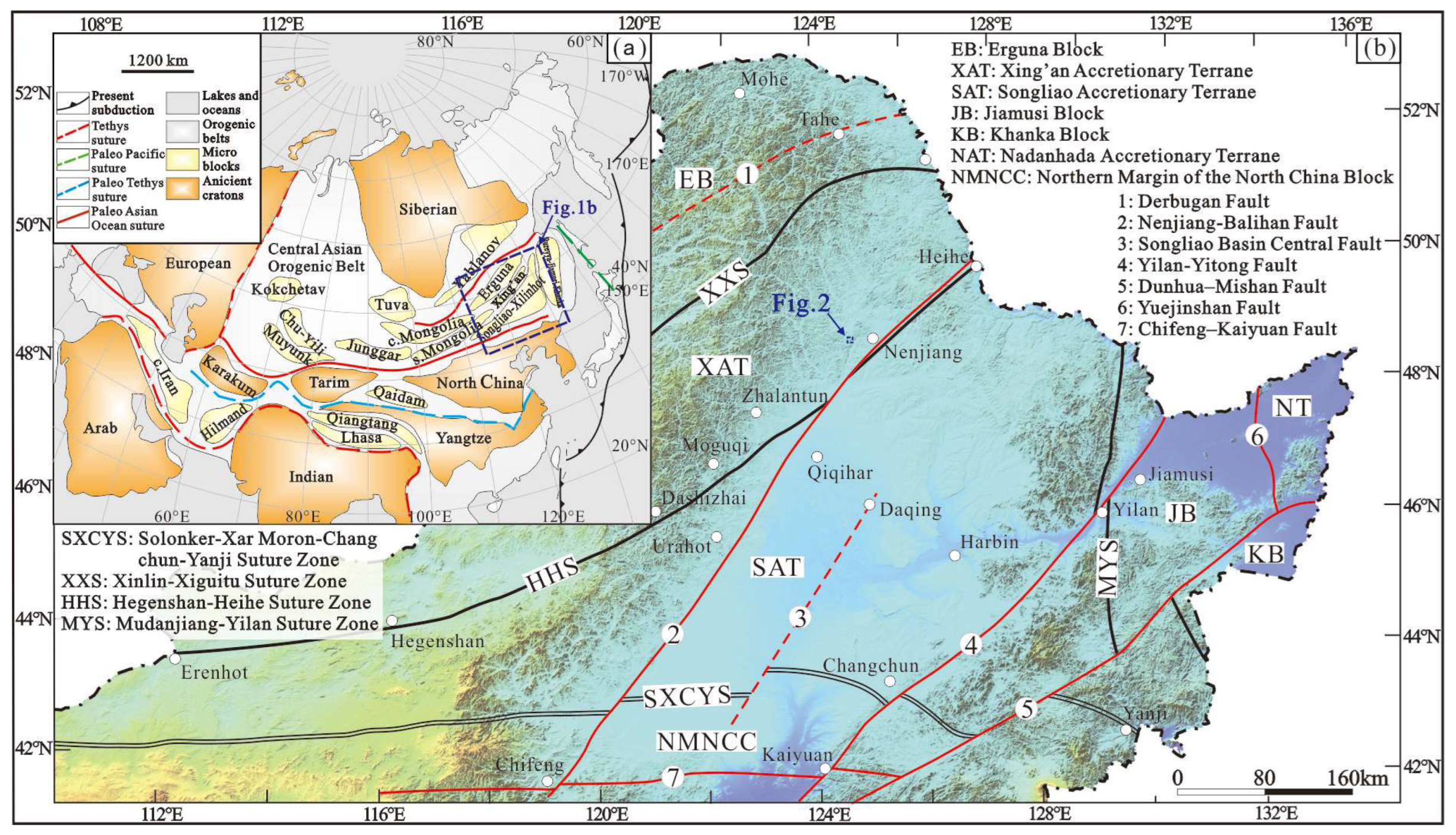
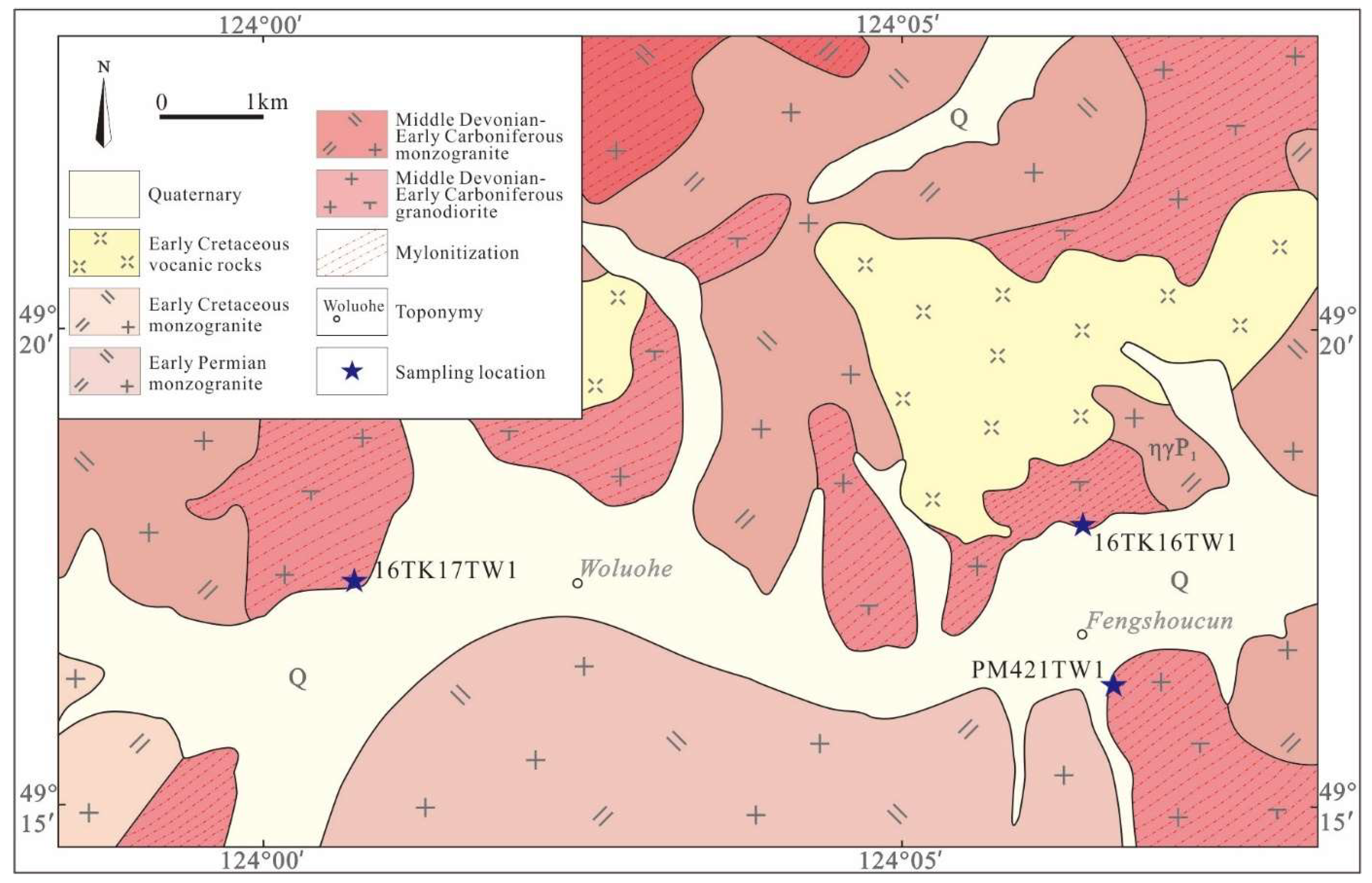
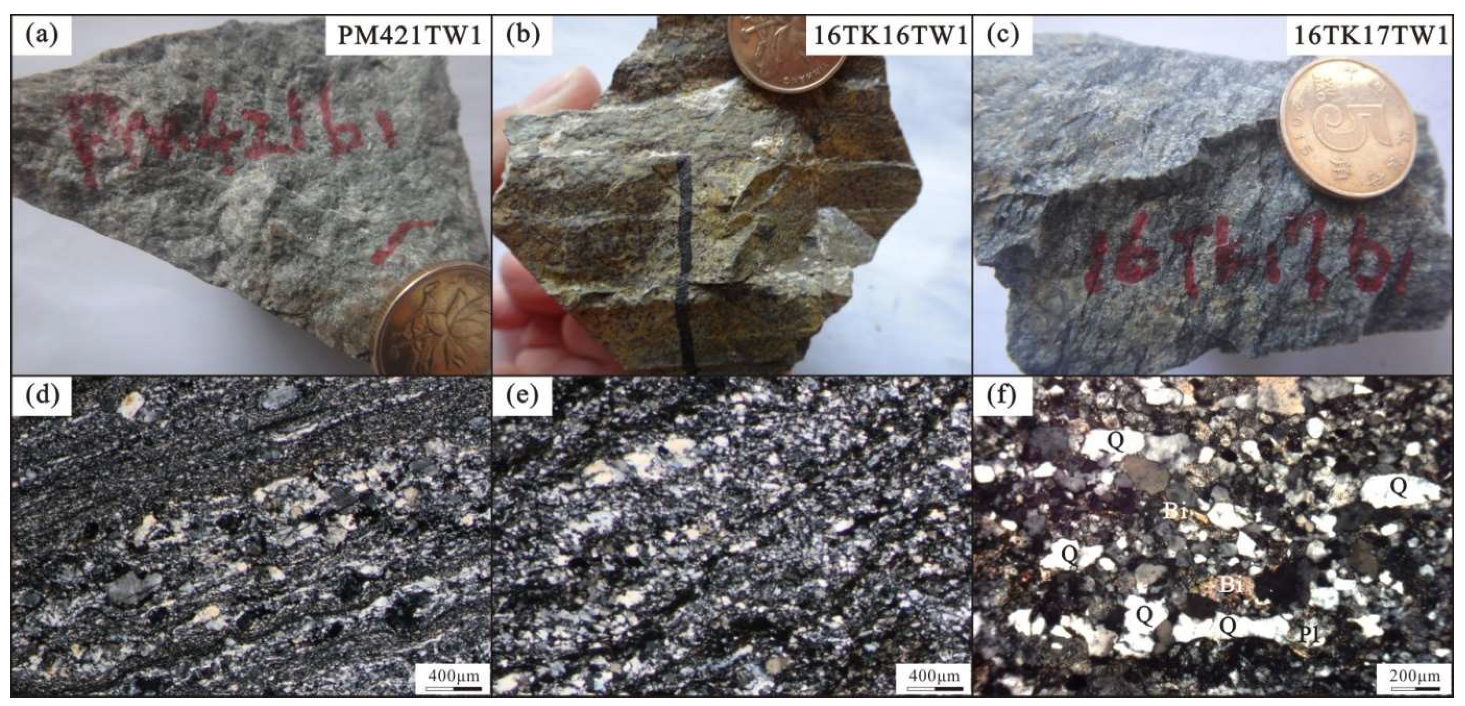


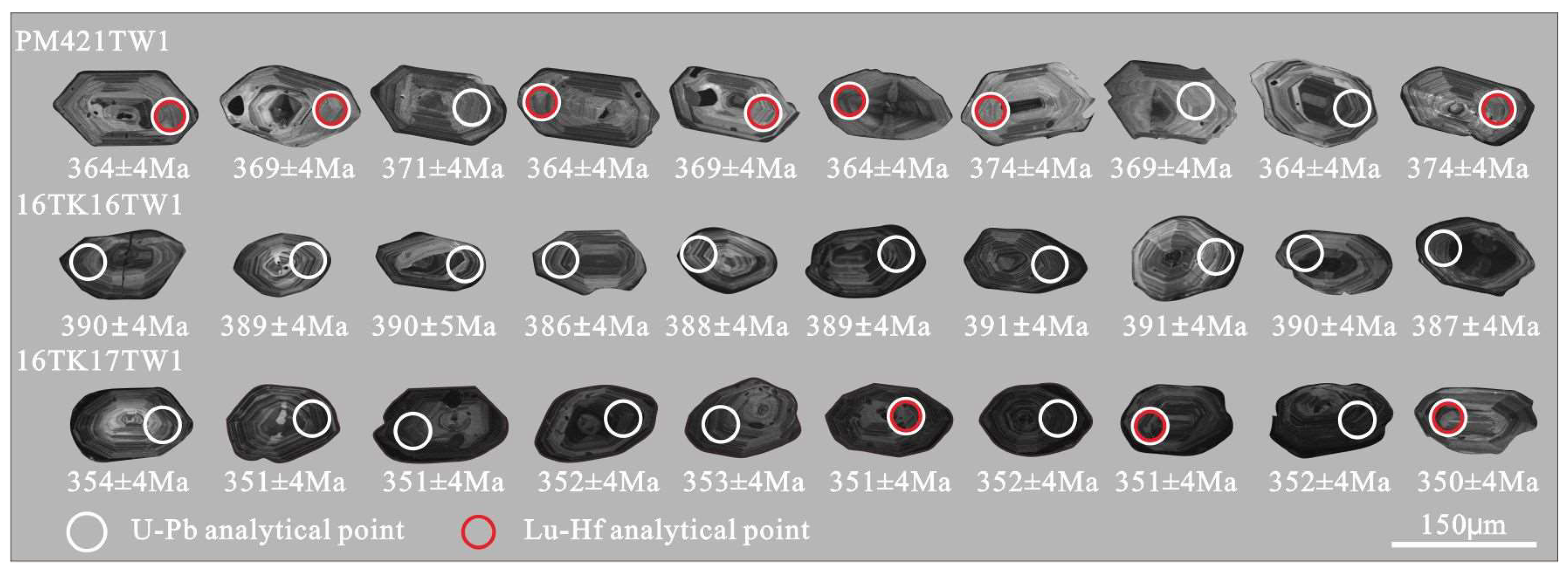
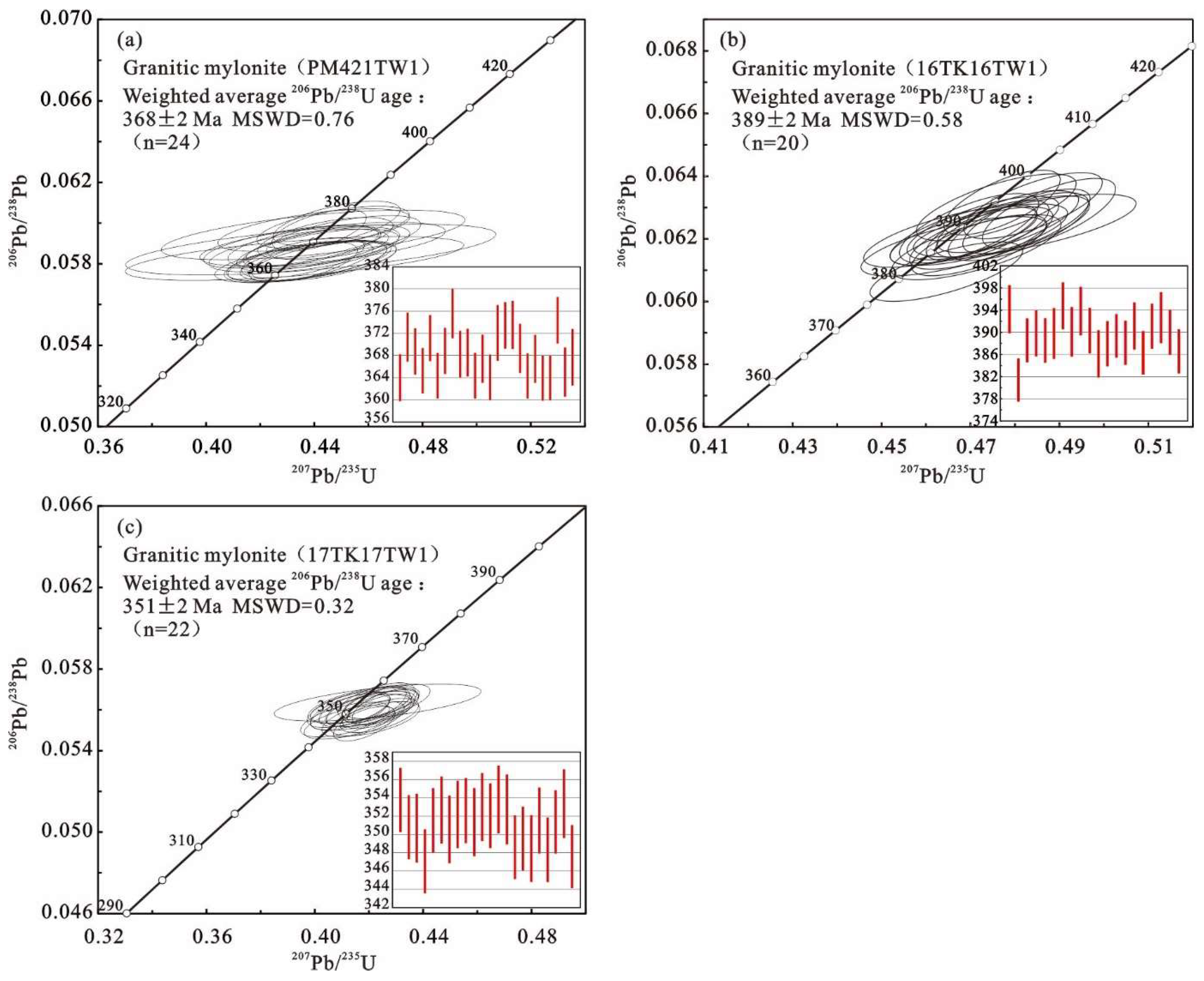
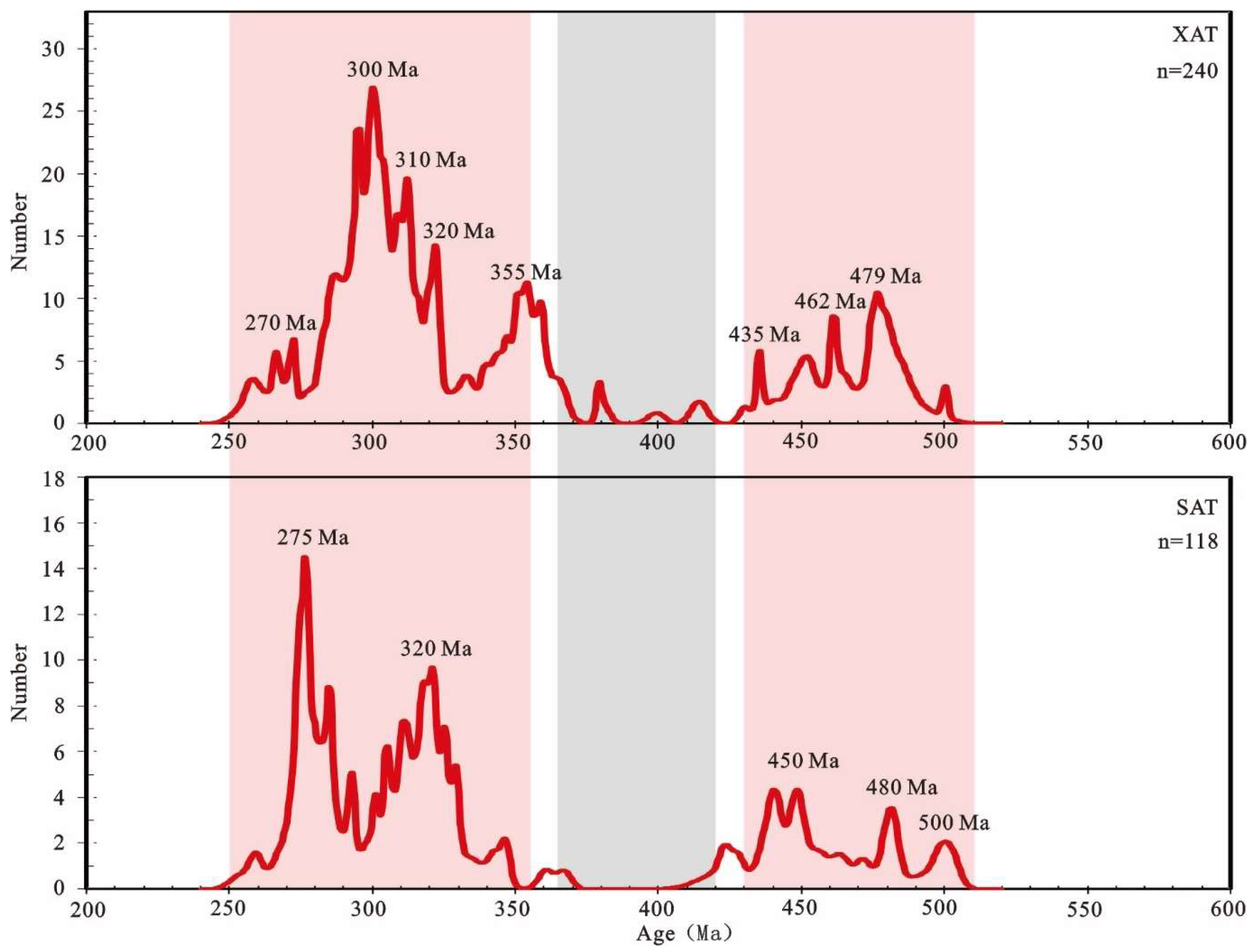


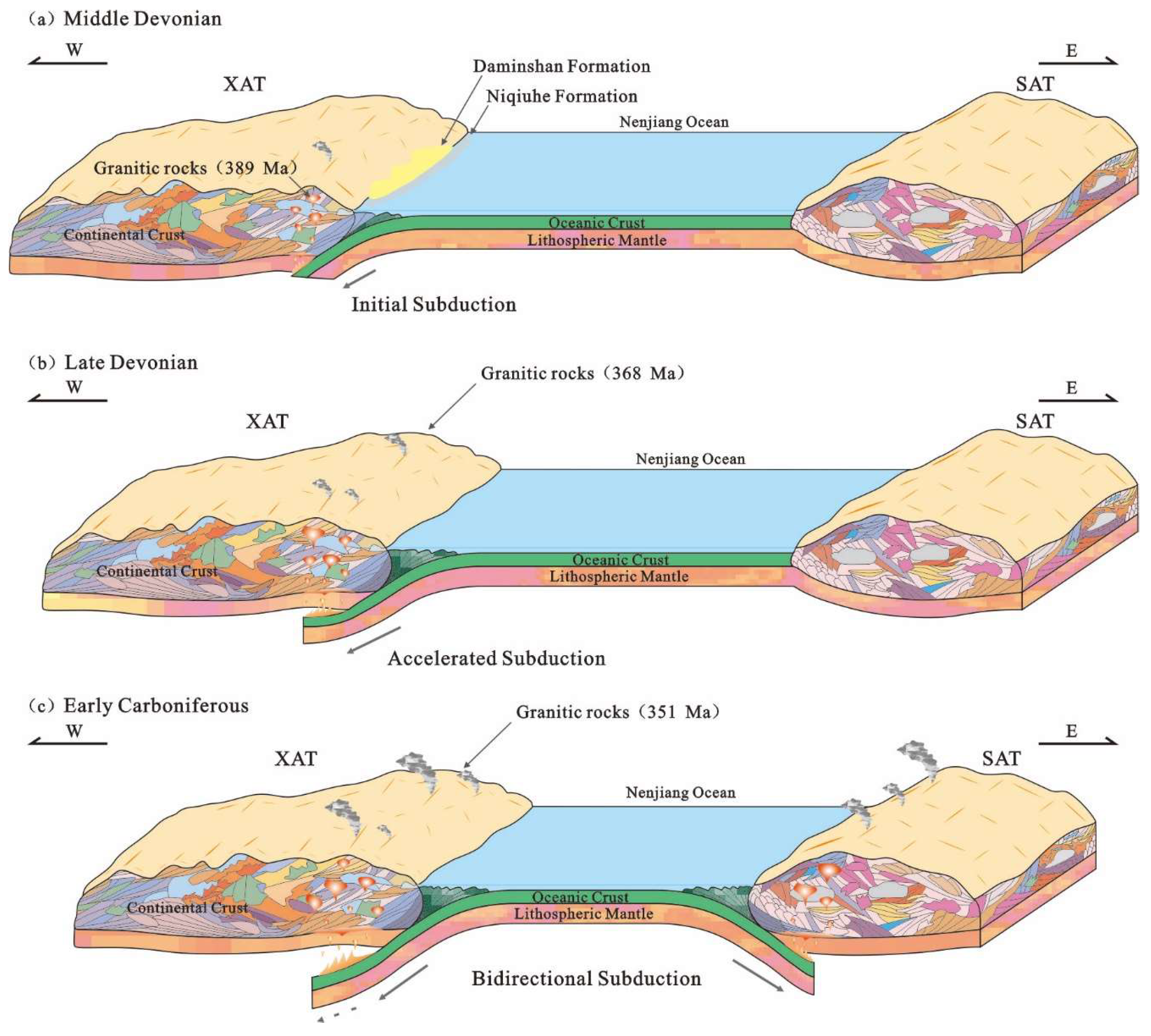
Disclaimer/Publisher’s Note: The statements, opinions and data contained in all publications are solely those of the individual author(s) and contributor(s) and not of MDPI and/or the editor(s). MDPI and/or the editor(s) disclaim responsibility for any injury to people or property resulting from any ideas, methods, instructions or products referred to in the content. |
© 2023 by the authors. Licensee MDPI, Basel, Switzerland. This article is an open access article distributed under the terms and conditions of the Creative Commons Attribution (CC BY) license (https://creativecommons.org/licenses/by/4.0/).
Share and Cite
Zhang, L.; Ma, Y.; Liu, Y.; Yuan, S.; Yang, H.; Li, W.; Liang, C.; Feng, Z. Tectonic Transition from Passive to Active Continental Margin of Nenjiang Ocean: Insight from the Middle Devonian-Early Carboniferous Granitic Rocks in Northern Great Xing’an Range, NE China. Minerals 2023, 13, 1003. https://doi.org/10.3390/min13081003
Zhang L, Ma Y, Liu Y, Yuan S, Yang H, Li W, Liang C, Feng Z. Tectonic Transition from Passive to Active Continental Margin of Nenjiang Ocean: Insight from the Middle Devonian-Early Carboniferous Granitic Rocks in Northern Great Xing’an Range, NE China. Minerals. 2023; 13(8):1003. https://doi.org/10.3390/min13081003
Chicago/Turabian StyleZhang, Li, Yongfei Ma, Yongjiang Liu, Sihua Yuan, Hongzhi Yang, Weimin Li, Chenyue Liang, and Zhiqiang Feng. 2023. "Tectonic Transition from Passive to Active Continental Margin of Nenjiang Ocean: Insight from the Middle Devonian-Early Carboniferous Granitic Rocks in Northern Great Xing’an Range, NE China" Minerals 13, no. 8: 1003. https://doi.org/10.3390/min13081003
APA StyleZhang, L., Ma, Y., Liu, Y., Yuan, S., Yang, H., Li, W., Liang, C., & Feng, Z. (2023). Tectonic Transition from Passive to Active Continental Margin of Nenjiang Ocean: Insight from the Middle Devonian-Early Carboniferous Granitic Rocks in Northern Great Xing’an Range, NE China. Minerals, 13(8), 1003. https://doi.org/10.3390/min13081003









